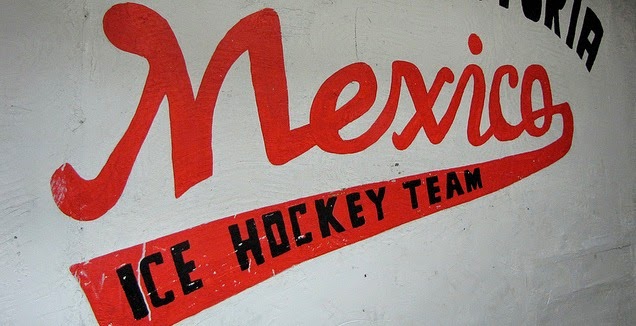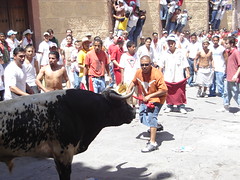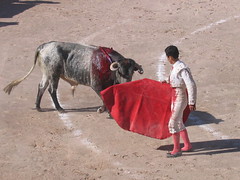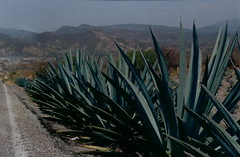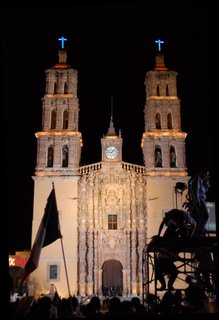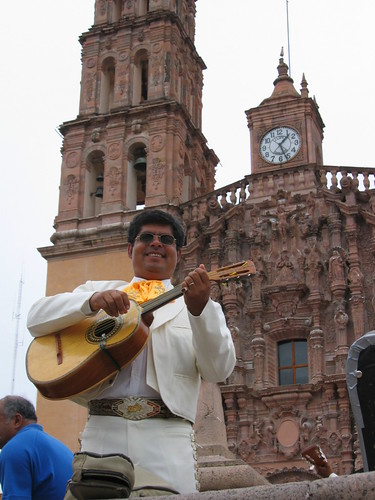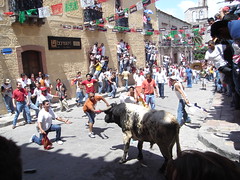
Bulls, being taunted and teased by want-to-be
toreros raced around a circuit in central San Miguel de Allende yesterday afternoon in the annual Sanmiguelada, the colonial town's version of Pamplona, Spain's running of the bulls. After being crushed in a narrow spectator area and nearly being bowled over by a motley group of runners -
naco punks, dare I call them - who insisted on leaving the course through a tightly-packed section, dodging angry bulls would have been more fun, safer and a lot more comfortable than standing for hours, pressed against a brick wall.
The event, which draws college-age students from across Mexico, grates on many locals, who populate a rather genteel spot - fiesta de los locos and weekly excess fireworks day excluded - that mostly attracts people from north of the border. (After two people were shot in a post-race dust up, it could become even less popular.) Numerous coffee shops and boutiques shut down yesterday. Public drinking was ubiquitous - despite a
ley seca (dry law). The eye candy, however, was impressive and the night life: active.
But on the whole, the event is largely over-rated. I wrote a more descriptive piece on the Sanmiguelada for
today's edition of The Herald Mexico.
Annual event re-examined
BY DAVID AGREN
El Universal
September 24, 2006
SAN MIGUEL DE ALLENDE, Gto. - Like most of the revelers in San Miguel de Allende on Saturday for the annual running of the bulls, U.S. exchange student David Darmitzel and four friends came to the colonial city on a lark, leaving Mexico City late Friday night and sleeping in a park due to a lack of hotel space.
"We´ve got our fuel ... we got an hour of sleep," he boasted while sipping a can of Red Bull, a caffeine-laden energy drink, two hours before the event started.
"We´re fearless."
An estimated 20,000 tourists descended on San Miguel for the annual Sanmiguelada, the Guanajuato town´s version of Pamplona, Spain´s annual running of the bulls. In addition to partying hard, most of the young visitors mainly stood in crushing crowds on the sidelines, watching local youngsters taunt and evade angry bulls, although a few tourists also participated. The annual influx swells the coffers of locals bars and hotels; the local tourism office figured visitors spend US$1.5 million.
But many residents and some business owners grouse about the event´s impact on the town, bemoaning the excessive public drinking and the spring-break style of tourism being promoted in a place that normally attracts a somewhat genteel crowd - to both visit and reside.
"Of the local people, maybe 50 percent are against it," said Dr. Roberto Maxwell, director of the Cruz Roja. "I call this the weekend of sex, booze and drugs."
To maintain order and cut down on injuries, the municipal government brought in 160 additional police officers from neighboring towns and imposed a
ley seca (dry law), which outlawed retail liquor sales and public drinking prior to the event. Furthermore, bars couldn´t open until 2 p.m. on Saturday.
Dr. Maxwell attributed a decline in injuries over the past decade to the crackdown, although liquor-company sponsorships were virtually everywhere, including the downtown course.
Fifteen years ago, more than 200 injuries were reported. After 47 were injured last year, this year´s preliminary figure was 53 injuries.
"The most common thing is that people are injured by their fellow runners," Dr. Maxwell explained. "It´s rare that someone gets gored."
RITE OF PASSAGE
Many of the Sanmiguelada participants run every year and learn to survive the stampede-like frenzy unharmed. Adán Canelo, 17, a student in Celaya, Guanajuato, said the best way to avoid injury was "not to get close to the bull."
While according to many spectators, the bulls in this year´s event were somewhat less aggressive than before, a number of participants failed to heed his advice.
For local youths, running with the bulls has become a rite of passage, according to Antonio Rivera, a taxi driver, who ran three times as a teenager.
"A lot of the young people here participate," he said, adding, "Most of the adults enjoy watching it at home on television instead."
According to Guillermo González, general manager of the San Miguel Tourism Board, the Sanmiguelada started 33 years ago after a group of friends, including the then-mayor, organized the first event for both recreational reasons and as a way to promote the town. Virtually no one attended the first Sanmiguelada, but it slowly grew in popularity, becoming a weekend for students to invade the town.
"A lot of young people come because it´s the cool thing to do," said Blanca Hinojosa, 21, a university student from Monterrey, while sipping an enormous margarita in Mama Mía, a bar near the Jardín in the center of town.
Like many visitors, she came ready for anything, including the ley seca.
"We brought our own stuff. We came prepared," said Hinojosa.
SOME SHOPS CLOSE
Thrill seekers brought in by the Sanmiguelada prompted many coffee shops and boutiques to close early. Estela González normally waits on tables each Saturday at La Buena Vida, a bakery cafe, but she was given the day off.
"We sell baked goods ... but young people only come looking for beer and alcohol," she explained.
"They all come looking to use the bathroom for free."
Detlev Kappstein, owner of Berlin, a restaurant-bar, said his usual clientele stays home during the Sanmiguelada and that to keep order in his establishment, he planned to work as a bouncer this weekend. Still, he understands why some business owners welcome the Sanmiguelada.
"Most of (the visitors) are kids with money," he explained.
"They come with their parents´ credit cards."
Guillermo González played down some of the complaints, saying, "The tourists mostly come for the (post-Sanmiguelada) bullfights and the nightlife." (Unlike in Pamplona, the bulls in the Sanmiguelada are not killed afterward in a bullfight.)
"It´s one day. It´s not similar to the beach ... like spring break," he added.
Some restaurant employees concurred.
"San Miguel is a tourist spot," said Alejandro Reséndiz, a bartender at Mama Mía.
"This is how the economy works."

